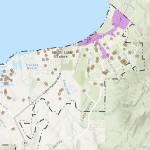South shore housing workshop will help shape TRPA code changes
SOUTH LAKE TAHOE, Calif. – The Tahoe Regional Planning Agency (TRPA) held its south shore housing workshop, gathering public input for the next phase of the Tahoe Living plan. TRPA is planning on making major changes to their development codes to help create more affordable and workforce housing in the basin.
During the presentation, long range program manager Karen Fink and senior planner Jacob Stock spoke about the importance of the public helping to shape these code changes. “We want to align TRPA codes with the local residents and workforce to better address housing needs,” said Fink.
Historically, while the TRPA’s development rights system and land use policies have helped to limit urbanization around the lake, they has also incentivized developers to build more single-family homes that are often unaffordable to the local populace.
Development rights for housing require a residential unit of use (RUU). However, a single-family home requires one RUU, while apartments require an RUU per room. These stipulations make it more costly to develop multi-family dwellings.
Land use policies require environmental mitigation, which with the TRPA is done through land coverage. A certain amount of required land coverage is needed for each project in order to protect the watershed and water quality, but it makes it harder for smaller projects with less land (which are usually more affordable) to be built closer together, even when near transit and services.
Costs for construction are high in the region, making it harder to create housing that is affordable and also feasible for the developers. TRPA is also considering reducing their mitigation fees in town centers or not requiring upfront fees for smaller projects.
Lastly, accessory dwelling units (ADUs) are a possible way to develop quick and cost-effective housing, but there’s not many of them around Lake Tahoe. It’s still costly to build these because of lot coverage and development rights, along with the permitting fees needed.
Stock and Eric Yurkovich, principal at Raimi and Associates, helped to outline the different options for the code updates.
- Development rights
- Option 1: Scale development rights based on home size
- Option 2: Keep the current system with waivers/incentives for housing
- Option 3: Require short-term rentals (STRs) to get a tourist accommodation use (TAU) development right, which would provide revenue to support housing.
- ADUs
- Option 1: Waive development right and lot coverage requirements for ADUs under 750 square feet.
- Option 2: Scale development rights for ADUs
- Development costs and fees
- Option 1: Charge scaled fees that correspond to environmental and community impacts for the home size
- Option 2: Reduce mitigation fees in town centers
- Land coverage
- Option 1: Allow more flexibility for meeting water quality standards without land coverage limits
- Option 2: Allow more coverage of multi-family housing, eliminate fee requirements so long as environmental analysis shows that water quality will be protected
- Option 3: Use more current soil maps to determine land coverage limits
- Development standards and zoning
- Option 1: Let local governments adopt development standards to incentivize housing
- Option 2: Expand town center boundaries so more properties can use incentive standards
- Option 3: Allow duplexes and where, appropriate, up to fourplexes in single-family home areas
TRPA representatives helped to clarify questions in small groups, where people were able to directly share their thoughts and rank how they felt about each option.
People expressed their concerns that updated codes could lead to exploitation from bigger developers rather than incentivizing affordable, achievable and workforce housing. Some asked for provisions that would be specific to achievable housing, similar to inclusionary zoning or requiring developers to also create affordable housing if they built another development.
On the whole, there was strong support for STR fees to provide revenue, progressive scaling of development fees while recouping fees for environmental protection, expanded town centers and duplex building, allowing more land coverage for multi-family housing, updating soil maps and changing development rights for ADUs.
There was also more support than expected for more local government control as well as utilizing the ability to deed-restrict houses for certain income levels. One notable ask was for the TRPA to also focus on accessible housing and housing for seniors.
Attendees were generally enthusiastic and curious about the process, but felt that this was an opportunity for leveraging major change in the development and building process in the Lake Tahoe area.
Another workshop for north shore took place on Tuesday night. TRPA will be compiling these responses for consideration for the Tahoe Living Plan.
Eli Ramos is a reporter for Tahoe Daily Tribune. They are part of the 2024–26 cohort of California Local News Fellows through UC Berkeley.

Support Local Journalism

Support Local Journalism
Readers around the Lake Tahoe Basin and beyond make the Tahoe Tribune's work possible. Your financial contribution supports our efforts to deliver quality, locally relevant journalism.
Now more than ever, your support is critical to help us keep our community informed about the evolving coronavirus pandemic and the impact it is having locally. Every contribution, however large or small, will make a difference.
Your donation will help us continue to cover COVID-19 and our other vital local news.











